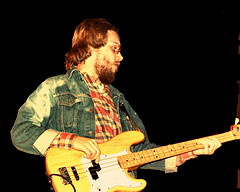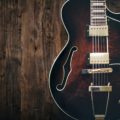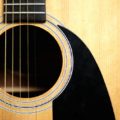Learn how to manipulate and shape your sound in a way that sets you apart from the rest of the crowd. We will provide some great tips on how you can make some simple adjustments that will give you a very unique style.
First and foremost, be yourself. Who are you as a guitarist?
We’ve all had moments where we wished we had the skill and sound of another guitarist. For some of us, this comparison happens daily and can either motivate us to work harder or leave us feeling discouraged. Unfortunately, the reality is that 95% of us will never sound exactly like our heroes. Why? Simply because we don’t have the same time, resources, or natural abilities as they do. This may sound harsh, but it’s actually a good thing when put into the context of our own playing. Anyone can pick up a tab book and play a song, but it takes a true guitarist to make it their own.
If you take the time to study some of your guitar heroes today, you’ll notice that they developed their own unique style by integrating techniques from other guitarists and blending them together. Many of them also drew inspiration from various genres and combined elements to create something entirely new.
Some excellent examples of these players include Santana, Jimmy Page, Jeff Beck, Kurt Cobain, Pete Townshend, and more. You might be wondering why I mentioned money as one of the reasons why most of us can’t sound like these players. While you can emulate some of their tones, it’s challenging to fully replicate them because they often have thousands of dollars’ worth of gear.
However, don’t be discouraged. With a few simple adjustments and some creative inspiration, you can start developing a unique style and tone that truly represents you.
Start by listening.
Before embarking on your journey to create your distinctive style, I highly recommend looking through our previous articles and doing some research. Don’t be afraid to explore different styles and genres to discover what resonates with you the most.
Do some Google searches for different styles of music. Another great resource is billboard.com, where you can find charts of the latest top songs that will give you an idea of what’s popular in contemporary terms. Visiting your local music store can also be immensely helpful.
From there, make a list of your favorite artists from these different genres. Try to identify the similarities and differences among them. Pay attention to the small details that you particularly enjoy. This could be anything from a unique strumming technique to a specific way they move their fingers across the fretboard to create a certain effect.
Take the traits you love from these artists and blend them together. Everyone adds their own personal touches, and how you use them is up to you. It won’t happen overnight, but with practice and persistence, you will find your own groove. The end result will be a style that reflects who you are and the music you love.
Look at the pros.
Taking the previous tip to the next level, let’s consider some professional guitarists and the music they play. Many of them come from diverse backgrounds, which is what makes them special. Exploring the genres associated with these familiar names can help you discover different styles to incorporate into your playing.
David Gilmour (Pink Floyd) – Gilmour is considered one of the most unique guitarists of the 20th century. He developed his sound by using a Stratocaster, HiWatt amps, and an array of effects pedals. It was his innovative use of these effects pedals that set him apart. He employed techniques that many have yet to emulate, making him a fascinating guitarist to study.
Ritchie Blackmore (Deep Purple) – If you aspire to incorporate a wide range of diametrically opposed styles, then Ritchie Blackmore is the guitarist to look up to. Blackmore had the ability to blend country and traditional music into rock guitar, which is fitting considering he started on a classical guitar Tuning Classical Guitar - No matter your level of classical guitar playing proficiency, it is always crucial to have a properly tuned classical guitar. This is especially important when playing an acoustic guitar, as each string's tone is quite prominent. There are numerous tuning variations for a guitar, but in this article, we will only cover Standard E tuning.… before switching to electric later on.
Who inspired Inspired by nature - Artist Robert Tucker talks about himself and his artist experience in this exclusive article. Inspired by nature The glorious portal of a new year is again upon me. My mind has wondered since the start of 2008 as to which direction my creative self will take. For me a torrent of feelings were released in… him? His primary influences were players like Hank Marvin and Duane Eddy, among many others. You may not have heard of them, but Hank Marvin was the frontman for the 60s group, The Shadows.
Jimmy Page (Led Zeppelin) – Jimmy is an incredibly versatile guitarist who combines techniques from various aspects of playing to create his own signature sound. He is a master of experimentation, using everything from violin bows to acoustic playing styles on an electric guitar How to Buy a Guitar - The guitar is known for its dynamic and unique sound, making it a popular instrument in various genres of music. Whether you're a beginner or someone with a growing passion for guitar playing, here are some top tips for buying a guitar: Seek out advice. Start by seeking guidance from someone you know who has… . He also has a history of using some really cool effects pedals, although he doesn’t rely on them to sound good.
In fact, one of his early custom effects units happened to be one of the first fuzz boxes introduced to the world. It quickly gained popularity among the world’s most renowned guitarists. However, no one could truly enhance its sound quite like Jimmy could, not even the likes of Jeff Beck.
Django Reinhardt (Quintet of The Hot Club of France) – Anyone familiar with jazz knows this name. While Django was considered a gypsy guitarist, he played the role of the mentor rather than the one taking tips from others. Over the years, some have managed to replicate his lightning-fast riffs and intuitive phrasing style. On top of that, his strumming patterns were mind-blowing!
Another interesting fact about this brilliant musician is that he began his musical journey by playing other instruments like the violin Play the Violin - A Whole Novice's Guide - The violin, also known as a fiddle, is a bowed string instrument. It has four strings that are tuned in perfect fifths. The violin is the smallest and highest pitched member of the string instrument family, which also includes violas and cellos. Although playing the violin can be quite challenging, when mastered, it produces a… and banjo. This explains a lot about the music he created. Notes that are close together on a violin are far apart on a guitar, but Django broke that barrier and incorporated many of those techniques. I believe his strumming style was adapted from the banjo.
I highly recommend exploring some of his masterpieces to test your technical ability and develop as a guitarist. Despite having only two functional fingers for playing guitar due to a fire accident, Django achieved remarkable feats.
Scotty Moore (Elvis Presley) – Moore revolutionized the guitar world by introducing driving rhythms and interesting chord progressions. He kept things simple, and that’s what made him famous. His music complemented Elvis because it didn’t overshadow the vocals, and he never aimed to steal the spotlight.
The coolest piece of gear that set Moore apart was his Echosonic amp. Only 68 were ever produced in the world, and he still has his to this day. It featured an impressive built-in delay system that gave him his characteristic sound. These handcrafted amps were unbeatable. Truly a rare, once-in-a-lifetime find. Without it, Elvis wouldn’t have had the same iconic sound on his records that transformed music history.
It all comes down to your fingers.
When I began my musical journey, I came across a saying that goes something like this: “Find your voice.” What allows us to sound good on any guitar is our technique. And what enables us to have good technique? That’s right, our fingers!
Our fingers can be compared to soldiers on a battlefield. They are our first line of defense and set the tempo for everything to come. Training them to be the best they can be is a crucial step in developing your own style. Sloppy fingers will get you nowhere quickly in the guitar world.
Ideally, your fingers should possess the strength to effortlessly handle bar chords and the agility to navigate the fretboard with minimal effort. It is crucial to recognize that agility and strength are key factors often overlooked by guitarists who mistakenly believe that finger muscles are fully developed.
Contrary to popular belief, having thicker fingers does not automatically grant the ability to endure extended periods on the fretboard. Just like in an army, individual training for each finger is necessary to attain optimal proficiency.
Manuel Marino is a seasoned Senior Producer, Music Composer, and Artist with over a decade of experience. He specializes in branded entertainment across various mediums, including video games, films, and advertising campaigns. With 20+ years as a game music composer, Manuel has worked on numerous platforms, creating diverse orchestral soundtracks. HIRE ME


 Manuel is a passionate, driven, and techsavvy AV technician,
Manuel is a passionate, driven, and techsavvy AV technician, 










